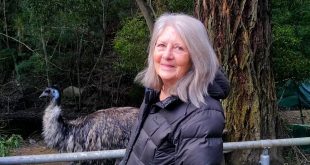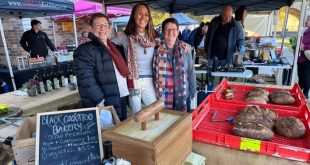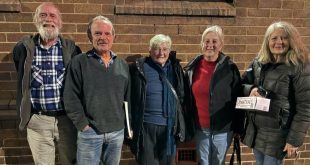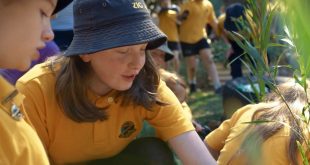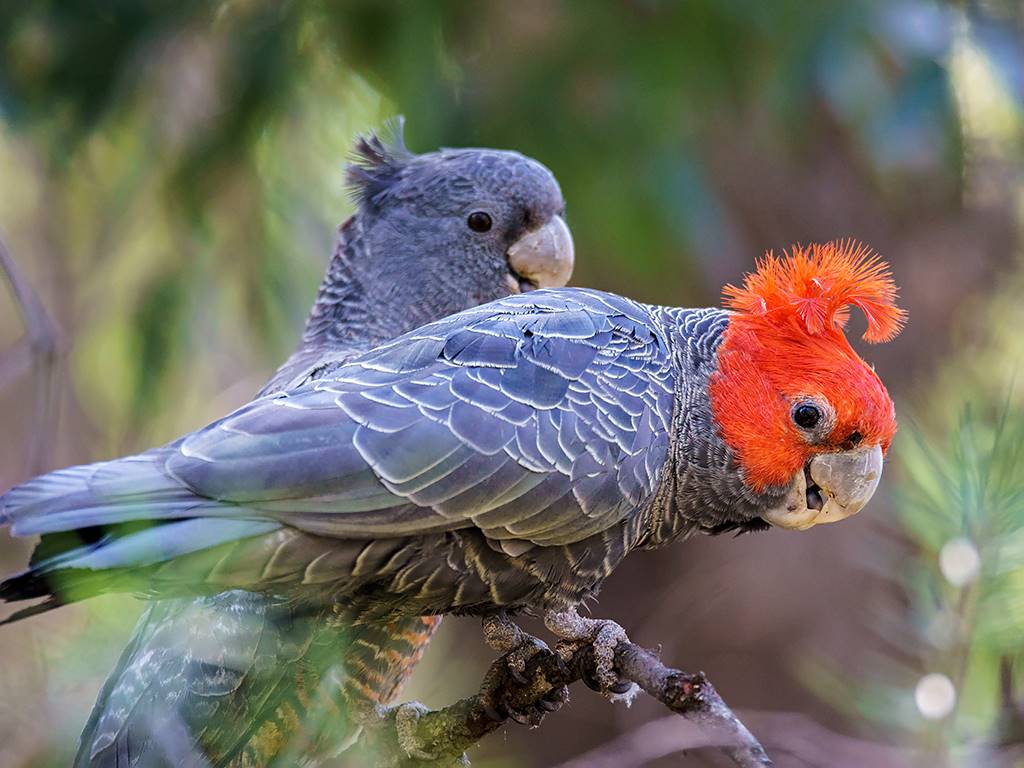
Gang Gang Cockatoos are now listed as a vulnerable species. (Photo: David Cook via Flickr, Creative Commons license.)
By Tracie McMahon
Threatened Species Day commemorates the day of the death of the last Tasmanian Tiger. It is a reminder of the vulnerability of our native flora and fauna and that we need to act before it is too late. In Lithgow, the once common ‘squeaky door’ call of the Gang Gang Cockatoo has become a rarity. On Threatened Species Day 2023, Lithgow and Oberon Landcare volunteers banded together at Farmers Creek to see what could be done to address their decline.
Key Points:
- The Black Summer bushfires are estimated to have impacted 3 billion native animals. Species such as Gang Gang Cockatoos are now listed as vulnerable.
- Planting trees along the creek lines of Lithgow replaces their habitat as well as stabilising banks to minimise the impacts of flood.
- Landcare hosts regular events throughout the Lithgow Area, providing all tools, equipment and training. There is no prior knowledge or skill requirement, and all ages are welcome.
Only ten years ago I would sit on my verandah in Little Hartley watching flocks of Gang Gangs soar overhead. My mother-in-law said they signalled the coming rain, but it’s been a long time since I’ve seen a flock and we’ve had a lot of rain!
National Threatened Species Day marks a ‘milestone’ day for Australia: the death of the last Tasmanian Tiger on 7 September 1936. The day was established in 1996 by WWF Australia and the Australian Government’s Natural Heritage Trust to “shine a spotlight on all the Australian native animal and plant species that are facing similar fates to that of the Tasmanian Tiger.” WWF Australia indicates that in 2023 there are over 565 native species currently listed as threatened. The Black Summer bushfires impacted nearly 3 billion animals. After the 19/20 fires the Gang Gang Cockatoo was rescheduled as ‘vulnerable’.
To be listed as vulnerable under the Environment Protection and Biodiversity Conservation Act 1999, one of the following indicators must be exhibited: a substantial reduction in numbers, a limited geographic distribution, a limited number of mature individuals, and evidence suggesting it will continue to decline, or the probability of extinction in the wild is at least 10% in the medium-term.
There are many that would throw their hands in the air, considering that the fire damage was too big and the loss irreversible, but there are others that believe that something can be done and will roll up their sleeves to do it. Members of the Lithgow and Oberon Landcare Association fall into this category. On Threatened Species Day they invited volunteers to join them to plant habitat on Farmers Creek near Geordie Street. Over 20 locals responded.

Poster for Threatened Species Day (LOLA supplied)
This section is now frequented by cyclists and walkers, enjoying the Farmers Creek cycleway that runs alongside the Creek. In 2017, when the Farmers Creek Precinct Masterplan was adopted by Lithgow City Council, it was described as degraded and prone to weed infestation. Today it is recovering from the extensive rain of 2022, including slippage of the natural banks, and regrowth of both natural grasses and weeds.
There are some benefits to all that soil and water movement. My self-elected task as a volunteer on Threatened Species Day is digging holes. Clumps of soft alluvial soil lift easily with a single swing of a mattock, revealing earthworms and a network of roots and fungal webs, ready to give the plantings a great start to life.

Farmers Creek Lithgow. Source Farmers Creek Precinct Masterplan. The Masterplan can be found here
The 2017 Farmers Creek Precinct Masterplan envisages redeveloping the area in three stages at a cost of over $9 million. The Masterplan suggests it will take close to two decades for Farmers Creek to realise its “enormous potential as a recreation and environmental asset”. Every plant inches this rehabilitation forward and it is inspiring to meet so many people willing to assist.
Volunteers include tiny tots learning how to hold a trowel to those with years of experience and their favourite trowel. Age, skill, strength and knowledge vary considerably, but all are welcome and there is much to do. Planting each individual seedling involves digging a hole, clearing surrounding vegetation, planting, assembling a tree guard, staking the tree guard around the new plant, gathering water from the creek, and finally watering the plant. Phew!
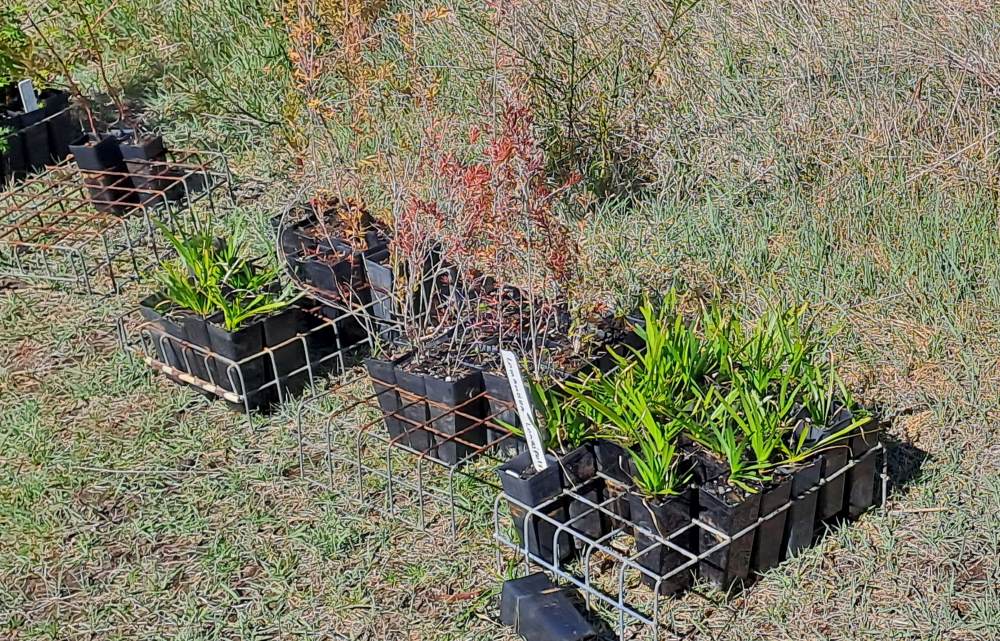
Species planted to create habitat for native fauna.
Before we begin, Steve Fleischmann, Landcare Coordinator, explains that the “planting is aimed at joining fragmented pockets of remnant bushland to create continuous stretches of riparian vegetation.” Riparian zones are those areas of vegetation alongside rivers or waterways that help protect the waterway. Plants have been chosen specifically for the vulnerable Gang Gang Cockatoo, but also to create the layers necessary for the health of the entire ecosystem.
Eucalyptus viminalis is a locally endemic tree species Gang Gangs have been seen in, while Leptospermum (tea tree) and Acacia (wattle) are roosting and food trees for several birds, including Gang Gangs. Lomandra longifolia helps to retain the banks and creates a ground level layering and food source for pollinators.
As we work, I ask my fellow volunteers what encouraged them to join in. Malcolm Reid, a Hartley resident and relative newcomer to the area, says it is an opportunity to learn and meet new people, while others see it as a commitment to the future.

Malcolm Reid, nicely warmed up after digging holes.
Lithgow High School Teacher Erika Marlin mentions her desire to set an example for students. It is Erika’s first event, and she says: “she wouldn’t ask her students to do anything she wouldn’t do herself.” As we speak, students Malakai and Malik Houzaifi turn up to lend a hand.
Others like Christine Bailey, author of a new book on the Purple Copper Butterfly, know intimately the value of habitat to the unique flora and flora of Lithgow, and are keen to ensure it is in abundance. As I look around, I comment that it is hard to imagine the tubestock we have planted morphing into shady trees, scent-laden shrubs and thick grasses, but a fellow volunteer pops his head up to remind me: “the true meaning of life is to plant trees under whose shade you do not expect to sit.”

Christine Bailey, hammering in tree guards.
I stop to check on the ‘hole to tubestock’ count, as the tub of tubestock is beginning to look a little bare. Greer Ashworth, one of the waterers, has lived in Lithgow most of her life and has been volunteering with Landcare for several years. I take time to check in with her too:
As 12.30 arrives, I look back over the area we have planted. After less than three hours, two hundred tubestock punctuate the creek bank, helping to stabilise 130 metres of degraded land, creating habitat for our native fauna and shade for walkers and cyclists on the nearby pathway. Perhaps one day I will sit under the shade of a towering Eucalypt as a flock of Gang Gangs soar overhead, but if not, well I am hopeful my children will.

Before: Pre-planting: The creek bank when it was bare, save for an abandoned bike.

After: Post planting: 200 mixed species have been planted to create layered habitat for Gang Gang Cockatoos and other species.
Take Action:
- Participate in a Landcare event. Steve Fleischmann, Landcare Coordinator, Lithgow & Oberon Landcare Association can be contacted on 0419 795 781 or steven.fleischmann@lithgow.nsw.gov.au for details of future events and to subscribe to their newsletter.
- Plant habitat in your own backyard. Lithgow and District Community Nursery can provide advice and tubestock. Open Saturday 9-1 pm and Friday and Monday 8.30-3.30 pm. 2A Coalbrook Street Lithgow.
- Learn more about Threatened Species Day at https://wwf.org.au/what-we-do/species/national-threatened-species-day/
Share this article:
This story has been produced as part of a Bioregional Collaboration for Planetary Health and is supported by the Disaster Risk Reduction Fund (DRRF). The DRRF is jointly funded by the Australian and New South Wales governments.
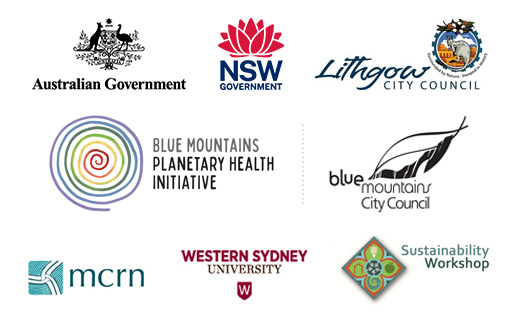
News From Around The Region
Did you know that old lino, window putty, and adhesive can contain asbestos? Yesterday the Asbestos & Hazardous Materials Management Conference kicked off with a pre-conference workshop at the Blue Mountains Planetary Health Centre. It included hands-on `spot the asbestos` and asbestos sampling sessions. This year`s theme is `Working together for a safe and healthy future`. #asbestos #hazardousmaterials #conference #planetaryhealth #bluemountains #katoomba
A huge thank you to Josh Logan from Logan Signs, Lithgow, for installing our Circular Water Signage in time for our World Animal Day Celebration today at the Blue Mountains Planetary Health Centre (33-39 Acacia St Katoomba). We have a full program of events with lots of information on how to prepare for the summer ahead and how to create urban areas that help us share our home respectfully with all species. It will be a fun family day too with storytime, craft and live music for kids! (Link in profile) #worldanimalday #planetaryhealth #familyday #katoomba #bluemountains
And our Wild Life exhibition is now up for World Animal Day tomorrow at the Blue Mountains Planetary Health Centre. Photographs by Warren Hinder, Merryl Watkins, Holly Kent and Tracy Burgess. Check out all the other events from stalls, talks, possum box demo, kid`s craft and animal storytime, plant based food and live music to Bushcare. @33-39 Acacia St Katoomba Link in profile. #planetaryhealth #worldanimalday #katoomba
Join the Blue Mountains Planetary Health Initiative at World Animal Day this Saturday 5 October for a discussion on the history of the Plant Based Food Movement in Australia and a discussion of exciting contemporary trends. It will be followed by a Plant Based Cheese Degustation to launch the Plant Inspired Community Cooking Project. This will be a series of cooking classes to introduce the community to plant based cooking techniques. The event is free but places are limited so bookings essential (link in profile): https://bit.ly/3Bzbwhu
#plantbasedcooking #worldanimalday #bluemountains #katoomba #planetaryhealth #communitycooking
We share the Blue Mountains with so many extraordinary beings but have you seen them and do you know their names? Do you know the difference between a Royal Spoonbill and an Eastern Shrike-tit, or the difference between a bandicoot and an antechinus? Come and check out our Wild Life Exhibition at World Animal Day this Saturday to learn more from the stunning photographs by Warren Hinder, Merryl Watkins, Holly Kent and Tracy Burgess. There will be also be a Breakfast with the Birds at 8.30am, Animal Storytime and Craft for kids from 10am, stalls, talks, food and live music. The day is free but please book via Eventbrite to help us cater (link in profile): https://bit.ly/4eMhbz0 @bluemountainswalks @merrylwatkinsphotography @bestofbluemountains
#royalspoonbill #easternshriketit #wildlife #birdsofthebluemountains #bluemountains #katoomba #worldanimalday #biodiversity #planetaryhealth
To coincide with the first day of Bushfire Season we launched Air Watch at the Planetary Health Centre yesterday. For the last seven years Blue Mountains Unions & Community have been working tirelessly to ensure residents of the Blue Mountains and Lithgow are able to measure and track the quality of the air we breathe. The Blue Mountains Planetary Health Initiative has worked closely with them over the last year and now there are 20 PurpleAir monitors distributed throughout the Blue Mountains and Lithgow, including one at the Planetary Health Centre. You can now view real time air quality measurements at each of our local news sites and on the Purple Air Map https://map.purpleair.com We have 10 more sensors available, so if you’d like to install a sensor, members of BMUC will be at World Animal Day at the Planetary Health Centre this Saturday 5 October to take applications and share more information about the project. Bookings for World Animal Day here (link in profile): https://www.eventbrite.com.au/e/world-animal-day-promoting-respectful-cohabitation-tickets-1029328889417
It was a fabulous day yesterday as each speaker highlighted how critically important this project is: Dr Rosemary Dillon CEO of Blue Mountains City Council Trish Doyle MP Dr Jenna Condie from Blue Mountains Parents for Climate Dr Maggie Davidson, environmental scientist from Western Sydney University Matthew Riley, Director Climate and Atmospheric Science from NSW Department of Climate Change, Energy, the Environment and Water and Peter Lammiman and Ann-Maree McEwan from the BMUC’s Airwatch Committee.
@bluemountainsunionists @nswdcceew @bluemountainscitycouncil @westernsydneyu @trishdoylemp @parentsforclimatebluemountains #airqualilty #airqualitymonitors #bluemountains #planetaryhealth
Treat yourself this weekend with a fun-filled and informative World Animal Day event at the Planetary Health Precinct in Katoomba. As well as a Breakfast with the Birds, stalls and a possum box demonstration, there will be a fabulous wildlife exhibition with photos by Warren Hinder, Merryl Watkins, Tracy Burgess and Holly Jayne; live music with Mem Davis, Joe Flood and Duck Keegan; lots of fun for kids with Sharon Baldwin and Naomi Crew leading animal storytime and craft with Julie Refferty; delicious plant based, gluten and dairy free treats, pastries and donuts from Clean Cravings; a plant based cheese degustation and warming Dahl, rice roasted cauliflower with veggies, pakoras, tamarind chutney, and salad courtesy of Bibi’s Kitchen. Come and learn more about Blue Mountains Bird Observers, Blue Mountains Conservation Society, WIRES, Action for Animals Blue Mountains and Animal Sanctuaries, Wombat Rescue, the Women’s Shed, and Animal Welfare Laws in Australia.
Guest speakers throughout the day will include Elizabeth Ellis, lecturer and author of Australian Animal Law; Hal Ginges, a local lawyer and animal activist from Action for Animals who advocates for animal rights and raises money for sanctuaries; Mark Berriman who has been President of the Australian Vegetarian Society NSW since 1989, as well as Co-ordinator for Animal Liberation NSW, Director of the Natural Health Society of Australia and the World League for Protection of Animals; and Teya Brooks Pribac, a researcher in the area of animal studies and the award-winning author of Enter the Animal. She’s also published Not Just Another Vegan Cookbook and will be sharing her culinary skills with the community in the Plant Inspired Community Cooking Project.
The event is free but please book your place to help us cater (link in profile): https://www.eventbrite.com.au/e/world-animal-day-promoting-respectful-cohabitation-tickets-1029328889417
#worldanimalday #plantbased #planetaryhealth #katoomba #bluemountains
We are so looking forward to kicking off World Animal Day Celebrations on Saturday 5 October with an 8.30am Breakfast with the Birds. Join Paul Nagle from the Blue Mountains Bird Observers on a guided bird walk around the Planetary Health Precinct visiting different habitats on the site to observe and talk about the birdlife that is resident and that visits the site. Binoculars are highly recommended.
World Animal Day will be an inspiring family day celebrating the extraordinary diversity of animals we share our world with! The theme is `Promoting Respectful Cohabitation`. Bookings for the Breakfast with the Birds (link in profile)
or here:
https://www.eventbrite.com.au/e/breakfast-with-the-birds-tickets-1028664983657
#birdlife #breakfastwiththebirds #katoomba #worldanimalday #bluemountains #planetaryhealth #respectfulcohabitation
We all need clean air to breathe, but how can we tell how clean our air is?
Thankfully the Air Watch subcommittee of Blue Mountains Unions & Community has worked for years to find ways to help us measure the quality of the air we breathe. Over the past year the Blue Mountains Planetary Health Initiative has worked with them to install Purple Air Quality monitors across our bioregion from Lithgow to the Lower Mountains. You can now view real time air quality on each of our Local News Sites!
Air Watch`s Purple Air quality monitors give the Blue Mountains` 78,000 residents, workers and 3 to 5 million/year visitors the power to make timely, informed decisions about their activities and health. It will also be a reliable source of data for the scientific community.
To coincide with the start of the Bushfire Season on Tuesday 1 October, we`re inviting the whole community to join us to launch Air Watch Blue Mountains and Lithgow at the Planetary Health Precinct. If you`d like to join us book a place here https://bit.ly/4dp2qko (link in profile)
#airquality #purpleair #bluemountainsunionscouncil #planetaryhealth #bluemountains #katoomba #bushfireseason
Today`s the day for the Blue Mountains Sustainability Festival! @bluemtns_sustainability_fest
We`ll be at the Speakers Forum at the Blue Mountains Cultural Centre at 10.15, talking about volunteer opportunities with the Blue Mountains Planetary Health Initiative, and then giving a presentation at 2.30pm. There`s a jam-packed speakers program, community stalls and workshops, and a Shopping Trail through Katoomba and Leura. You can find more information on the website at https://resilientbluemountains.org/sustainability-festival/
#sustainability #slowfashion #slowshopping #fashiontrail #circulareconomy #planetaryhealth #community #katoomba


